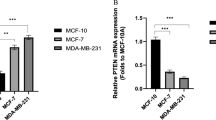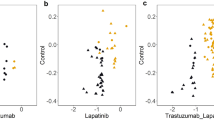Abstract
Aberrantly expressed microRNAs (miRNAs) are involved in breast tumorigenesis. It is still unclear if and how miRNAs-221/222 are implicated in breast cancer and the resistance to estrogen receptor modulator tamoxifen. We investigated the roles and mechanisms of miR-221/222 in breast cancer cells, particularly in modulating response to tamoxifen therapy. MCF-7 and MDA-MB-231 breast cancer cells were transfected with antisense oligonucleotides AS-miR-221 and AS-miR-222 and their expression of miR-221 and miR-222 was assessed. The correlation of miR-221/222 with tissue inhibitor of metalloproteinase-3 (TIMP3) expression was investigated by fluorescence quantitative PCR and western blotting analysis. The therapeutic sensitivity of these cells, transfected and untransfected, to tamoxifen was determined. Transfection of AS-miR-221 and AS-miR-222 dramatically inhibited expression of miR-221 and miR-222, respectively, in both MCF-7 and MDA-MB-231 cells (P<0.05–0.01). Downregulation of miR-221/222 significantly increased the expression of TIMP3 compared with controls (P<0.05–0.01). The viability of estrogen receptor (ER)-positive MCF-7 cells transfected with AS-miR-221 or/and AS-miR-222 was significantly reduced by tamoxifen (P<0.05–0.01). We have demonstrated for the first time that suppression of miRNA-221/222 increases the sensitivity of ER-positive MCF-7 breast cancer cells to tamoxifen. This effect is mediated through upregulation of TIMP3. These findings suggest that upregulation of TIMP3 via inhibition of miRNA-221/222 could be a promising therapeutic approach for breast cancer.
This is a preview of subscription content, access via your institution
Access options
Subscribe to this journal
Receive 12 print issues and online access
$259.00 per year
only $21.58 per issue
Buy this article
- Purchase on Springer Link
- Instant access to full article PDF
Prices may be subject to local taxes which are calculated during checkout






Similar content being viewed by others
Change history
03 October 2023
A Correction to this paper has been published: https://doi.org/10.1038/s41417-023-00672-5
References
Siegel R, Naishadham D, Jemal A . Cancer statistics, 2013. CA Cancer J Clin 2013; 63: 11–30.
Osborne CK, Schiff R . Mechanisms of endocrine resistance in breast cancer. Annu Rev Med 2011; 62: 233–247.
Giacinti L, Claudio PP, Lopez M, Giordano A . Epigenetic information and estrogen receptor alpha expression in breast cancer. Oncologist 2006; 11: 1–8.
Patani N, Martin LA . Understanding response and resistance to oestrogen deprivation in ER-positive breast cancer. Mol Cell Endocrinol 2014; 382: 683–694.
Lu Y, Roy S, Nuovo G, Ramaswamy B, Miller T, Shapiro C et al. Anti-microRNA-222 (anti-miR-222) and -181B suppress growth of tamoxifen-resistant xenografts in mouse by targeting TIMP3 protein and modulating mitogenic signal. J Biol Chem 2011; 286: 42292–42302.
Ambros V . The functions of animal microRNAs. Nature 2004; 431: 350–355.
Bartel DP . MicroRNAs: genomics, biogenesis, mechanism, and function. Cell 2004; 116: 281–297.
Iorio MV, Croce CM . MicroRNAs in cancer: small molecules with a huge impact. J Clin Oncol 2009; 27: 5848–5856.
Lagos-Quintana M, Rauhut R, Yalcin A, Mever J, Lendeckel W, Tuschl T . Identification of tissue-specific microRNAs from mouse. Curr Biol 2002; 12: 735–739.
Miska EA . How microRNAs control cell division, differentiation and death. Curr Opin Genet Dev 2005; 15: 563–568.
Esquela-Kerscher A, Slack FJ . Oncomirs-microRNAs with a role in cancer. Nat Rev Cancer 2006; 6: 259–269.
Bushati N, Cohen SM . microRNA functions. Annu Rev Cell Dev Biol 2007; 23: 175–205.
Filipowicz W, Bhattacharyya SN, Sonenberg N . Mechanisms of post-transcriptional regulation by microRNAs: are the answers in sight? Nat Rev Genet 2008; 9: 102–114.
Iorio MV, Casalini P, Piovan C, Braccioli L, Taqliabue E . Breast cancer and microRNAs: therapeutic impact. Breast 2011; 20 (Suppl 3): S63–S70.
Raouf A, Zhao Y, To K, Sting J, Delaney A, Barbara M et al. Transcriptome analysis of the normal human mammary cell commitment and differentiation process. Cell Stem Cell 2008; 3: 109–118.
Kendrick H, Regan JL, Magnay FA, Grigoriadis A, Mitsopoulos C, Zvelebil M et al. Transcriptome analysis of mammary epithelial subpopulations identifies novel determinants of lineage commitment and cell fate. BMC Genomics 2008; 9: 591.
Croce CM, Calin GA . miRNAs, cancer, and stem cell division. Cell 2005; 122: 6–7.
Zhao H, Shen J, Medico L, Wang D, Ambrosone CB, Liu S . A pilot study of circulating miRNAs as potential biomarkers of early stage breast cancer. PLoS One 2010; 5: e13735.
Guttilla IK, Phoenix KN, Hong X, Tirnauer JS, Claffey KP, White BA . Prolonged mammosphere culture of MCF-7 cells induces an EMT and repression of the estrogen receptor by microRNAs. Breast Cancer Res Treat 2012; 132: 75–85.
Miller TE, Ghoshal K, Ramaswamy B, Roy S, Datta J, Shapiro CL et al. MicroRNA-221/222 confers tamoxifen resistance in breast cancer by targeting p27Kip1. J Biol Chem 2008; 283: 29897–29903.
Zhang L, Wang T, Wright AF, Suri M, Schwartz CE, Stevenson RE et al. A microdeletion in Xp11.3 accounts for co-segregation of retinitis pigmentosa and mental retardation in a large kindred. Am J Med Genet A 2006; 140: 349–357.
Zhang C, Kang C, You Y, Pu P, Yang W, Zhao P et al. Co-suppression of miR-221/222 cluster suppresses human glioma cell growth by targeting p27kip1 in vitro and in vivo. Int J Oncol 2009; 34: 1653–1660.
Hui AB, Shi W, Boutros PC, Miller N, Pintilie M, Fyles T et al. Robust global micro-RNA profiling with formalin-fixed paraffin-embedded breast cancer tissues. Lab Invest 2009; 89: 597–606.
Yan LX, Huang XF, Shao Q, Huang MY, Deng L, Wu QL et al. MicroRNA miR-21 overexpression in human breast cancer is associated with advanced clinical stage, lymph node metastasis and patient poor prognosis. RNA 2008; 14: 2348–2360.
Zhang J, Han L, Ge Y, Zhou X, Zhang A, Zhang C et al. miR-221/222 promote malignant progression of glioma through activation of the Akt pathway. Int J Oncol 2010; 36: 913–920.
Pineau P, Volinia S, McJunkin K, Marchio A, Battiston C, Terris B et al. miR-221 overexpression contributes to liver tumorigenesis. Proc Natl Acad Sci USA 2010; 107: 264–269.
Garofalo M, Di Leva G, Romano G, Nuovo G, Suh SS, Ngankeu A et al. miR-221&222 regulate TRAIL resistance and enhance tumorigenicity through PTEN and TIMP3 downregulation. Cancer Cell 2009; 16: 498–509.
Nagase H, Visse R, Murphy G . Structure and function of matrix metalloproteinases and TIMPs. Cardiovasc Res 2006; 69: 562–573.
Cruz-Munoz W, Khokha R . The role of tissue inhibitors of metalloproteinases in tumorigenesis and metastasis. Crit Rev Clin Lab Sci 2008; 45: 291–338.
Ahonen M, Ala-Aho R, Baker AH, George SJ, Grénman R, Saarialho-Kere U et al. Antitumor activity and bystander effect of adenovirally delivered tissue inhibitor of metalloproteinases-3. Mol Ther 2002; 5: 705–715.
Edwards DR . TIMP-3 and endocrine therapy of breast cancer: an apoptosis connection emerges. J Pathol 2004; 202: 391–394.
Lewis JS, Jordan VC . Selective estrogen receptor modulators (SERMs): mechanisms of anticarcinogenesis and drug resistance. Mutat Res 2005; 591: 247–263.
Fan M, Yan PS, Hartman-Frey C, Chen L, Paik H, Over SL et al. Diverse gene expression and DNA methylation profiles correlate with differential adaptation of breast cancer cells to the antiestrogens tamoxifen and fulvestrant. Cancer Res 2006; 66: 11954–11966.
Baigude H, Rana TM . Interfering nanoparticles for silencing microRNAs. Methods Enzymol 2012; 509: 339–353.
Lambertini E, Lisignoli G, Torreggiani E, Manferdini C, Gabusi E, Franceschetti T et al. Slug gene expression supports human osteoblast maturation. Cell Mol Life Sci 2009; 66: 3641–3653.
Zampieri D, Nora LC, Basso V, Camassola M, Dillon AJ . Validation of reference genes in Penicillium echinulatum to enable gene expression study using real-time quantitative RT-PCR. Curr Genet 2014 (e-pub ahead of print).
Chen JL, Chang CJ, Wang JY, Wen CS, Tseng LM, Chang WC et al. In vitro and in vivo effects of Jia-Wei-Xiao-Yao-San in human breast cancer MCF-7 cells treated with tamoxifen. Integr Cancer Ther 2014 (e-pub ahead of print).
Zhao JJ, Lin J, Yang H, Kong W, He L, Ma X et al. MicroRNA-221/222 negatively regulates estrogen receptor alpha and is associated with tamoxifen resistance in breast cancer. J Biol Chem 2008; 283: 31079–31086.
Span PN, Lindberg RL, Manders P, Tjan-Heijnen VC, Heuvel JJ, Beex LV et al. Tissue inhibitors of metalloproteinase expression in human breast cancer: TIMP-3 is associated with adjuvant endocrine therapy success. J Pathol 2004; 202: 395–402.
Hancox RA, Allen MD, Holliday DL, Edwards DR, Pennington CJ, Guttery DS et al. Tumour-associated tenascin-C isoforms promote breast cancer cell invasion and growth by matrix metalloproteinase-dependent and independent mechanisms. Breast Cancer Res 2009; 11: R24.
Howe EN, Cochrane DR, Richer JK . The miR-200 and miR-221/222 microRNA families: opposing effects on epithelial identity. J Mammary Gland Biol Neoplasia 2012; 17: 65–77.
Hsu SH, Motiwala T, Roy S, Claus R, Mustafa M, Plass C et al. Methylation of the PTPRO gene in human hepatocellular carcinoma and identification of VCP as its substrate. J Cell Biochem 2013; 114: 1810–1818.
Si ML, Zhu S, Wu H, Lu Z, Wu F . MoYY. miR-21-mediated tumor growth. Oncogene 2007; 26: 2799–2803.
Chan JH, Lim S, Wong WS . Antisense oligonucleotides: from design to therapeutic application. Clin Exp Pharmacol Physiol 2006; 33: 533–540.
Obad S, dos Santos CO, Petri A, Heidenblad M, Broom O, Ruse C et al. Silencing of microRNA families by seed-targeting tiny LNAs. Nat Genet 2011; 43: 371–378.
Park JK, Kogure T, Nuovo GJ, Jiang J, He L, Kim JH et al. miR-221 silencing blocks hepatocellular carcinoma and promotes survival. Cancer Res 2011; 71: 7608–7616.
Meng F, Henson R, Lang M, Wehbe H, Maheshwari S, Mendell JT et al. Involvement of human micro-RNA in growth and response to chemotherapy in human cholangiocarcinoma cell lines. Gastroenterology 2006; 130: 2113–2129.
Acknowledgements
This study was supported by grants from the National Natural Science Foundation of China (81170257) and Zhejiang Provincial Natural Science Foundation (Y2110513).
Author information
Authors and Affiliations
Corresponding authors
Ethics declarations
Competing interests
The authors declare no conflict of interest.
Additional information
Supplementary Information accompanies the paper on Cancer Gene Therapy website
The original online version of this article was revised: Following the publication of this article, the authors noted that the panel in Figure 1b for AS-miR-221 had mistakenly been placed to show AS-miR-221/222. The correct panel for AS-miR-221/222 has now been included in the below revised figure. The conclusions of the article are unaffected by this correction.
Rights and permissions
About this article
Cite this article
Gan, R., Yang, Y., Yang, X. et al. Downregulation of miR-221/222 enhances sensitivity of breast cancer cells to tamoxifen through upregulation of TIMP3. Cancer Gene Ther 21, 290–296 (2014). https://doi.org/10.1038/cgt.2014.29
Received:
Revised:
Accepted:
Published:
Issue Date:
DOI: https://doi.org/10.1038/cgt.2014.29
This article is cited by
-
m6A demethylase ALKBH5 promotes tumor cell proliferation by destabilizing IGF2BPs target genes and worsens the prognosis of patients with non-small-cell lung cancer
Cancer Gene Therapy (2022)
-
miR-221/222 sponge abrogates tamoxifen resistance in ER-positive breast cancer cells through restoring the expression of ERα
Molecular Biomedicine (2021)
-
MiR-9-3p regulates the biological functions and drug resistance of gemcitabine-treated breast cancer cells and affects tumor growth through targeting MTDH
Cell Death & Disease (2021)
-
A comprehensive review on oncogenic miRNAs in breast cancer
Journal of Genetics (2021)
-
Non coding RNAs as the critical factors in chemo resistance of bladder tumor cells
Diagnostic Pathology (2020)



